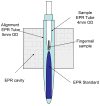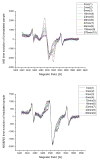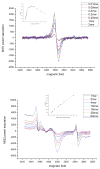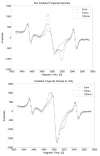Dosimetry based on EPR spectral analysis of fingernail clippings
- PMID: 20065699
- PMCID: PMC2818093
- DOI: 10.1097/HP.0b013e3181b27502
Dosimetry based on EPR spectral analysis of fingernail clippings
Abstract
Exposure of fingernails and toenails to ionizing radiation creates radicals that are stable over a relatively long period (days to weeks) and characterized by an isotropic EPR signal at g = 2.003 (so-called radiation-induced signal, RIS). This signal in readily obtained fingernail parings has the potential to be used in screening a population for exposure to radiation and determining individual dose to guide medical treatment. However, the mechanical harvesting of fingernail parings also creates radicals, and their EPR signals (so-called mechanically-induced signals, MIS) overlap the g approximately 2.0 region, interfering with efforts to quantify the RIS and, therefore, the radiation dose. Careful analysis of the time evolution and power-dependence of the EPR spectra of freshly cut fingernail parings has now resolved the MIS into three major components, including one that is described for the first time. It dominates the MIS soon after cutting, but decays within the first hour and consists of a unique doublet that can be resolved from the RIS. The MIS obtained within the first few minutes after cutting is consistent among fingernail samples and provides an opportunity to achieve the two important dosimetry objectives. First, perturbation of the initial MIS by the presence of RIS in fingernails that have received a threshold dose of radiation leads to spectral signatures that can be used for rapid screening. Second, decomposition of the EPR spectra from irradiated fingernails into MIS and RIS components can be used to isolate and thus quantify the RIS for determining individual exposure dose.
Figures








Similar articles
-
Ex vivo analysis of irradiated fingernails: chemical yields and properties of radiation-induced and mechanically-induced radicals.Health Phys. 2010 Feb;98(2):301-8. doi: 10.1097/HP.0b013e3181b0c045. Health Phys. 2010. PMID: 20065698 Free PMC article.
-
Development and validation of an ex vivo electron paramagnetic resonance fingernail biodosimetric method.Radiat Prot Dosimetry. 2014 Jun;159(1-4):172-81. doi: 10.1093/rpd/ncu129. Epub 2014 May 6. Radiat Prot Dosimetry. 2014. PMID: 24803513 Free PMC article.
-
Electron paramagnetic resonance in human fingernails: the sponge model implication.Radiat Environ Biophys. 2008 Nov;47(4):515-26. doi: 10.1007/s00411-008-0178-8. Epub 2008 Jun 27. Radiat Environ Biophys. 2008. PMID: 18584193
-
Evolution and Optimization of Tooth Models for Testing In Vivo EPR Tooth Dosimetry.Radiat Prot Dosimetry. 2016 Dec;172(1-3):152-160. doi: 10.1093/rpd/ncw215. Epub 2016 Aug 22. Radiat Prot Dosimetry. 2016. PMID: 27555657 Free PMC article. Review.
-
EPR dosimetry with tooth enamel: A review.Appl Radiat Isot. 2010 Nov;68(11):2033-116. doi: 10.1016/j.apradiso.2010.05.016. Epub 2010 Jun 4. Appl Radiat Isot. 2010. PMID: 20599388 Review.
Cited by
-
Ex vivo analysis of irradiated fingernails: chemical yields and properties of radiation-induced and mechanically-induced radicals.Health Phys. 2010 Feb;98(2):301-8. doi: 10.1097/HP.0b013e3181b0c045. Health Phys. 2010. PMID: 20065698 Free PMC article.
-
The world as viewed by and with unpaired electrons.J Magn Reson. 2012 Oct;223:151-63. doi: 10.1016/j.jmr.2012.07.025. Epub 2012 Aug 15. J Magn Reson. 2012. PMID: 22975244 Free PMC article.
-
Clinical EPR: unique opportunities and some challenges.Acad Radiol. 2014 Feb;21(2):197-206. doi: 10.1016/j.acra.2013.10.011. Acad Radiol. 2014. PMID: 24439333 Free PMC article. Review.
-
Advances towards using finger/toenail dosimetry to triage a large population after potential exposure to ionizing radiation.Radiat Meas. 2011 Sep;46(9):882-887. doi: 10.1016/j.radmeas.2011.05.016. Radiat Meas. 2011. PMID: 22125410 Free PMC article.
-
2013 Dade W. Moeller lecture: medical countermeasures against radiological terrorism.Health Phys. 2014 Aug;107(2):164-71. doi: 10.1097/HP.0000000000000082. Health Phys. 2014. PMID: 24978287 Free PMC article. Review.
References
-
- Alexander GA, Swartz HM, Amundson SA, Blakely WF, Buddemeier B, Gallez B, Dainiak N, Goans RE, Hayes RB, Lowry PC, Noska MA, Okunieff P, Salner AL, Schauer DA, Trompier F, Turteltaub KW, Voisin P, Wiley AL, Jr, Wilkins R. BiodosEPR 2006 meeting: acute dosimetry consensus committee recommendations on biodosimetry applications in events involving uses of radiation by terrorists and radiation accidents. Radiat Measur. 2007;42:972–996.
-
- Chandra H, Symons MCR. Sulphur radicals formed by cutting alpha-keratin. Nature. 1987;328:833–834. - PubMed
-
- Dalgarno BG, McClymont JD. Evaluation of ESR as a radiation accident dosimetry technique. Appl Radiat Isot. 1989;40:1013–1020.
-
- Gonzalez AJ. An international perspective on radiological threats and the need for retrospective biological dosimetry of acute radiation overexposures. Radiat Measur. 2007;42:1053–1062.
-
- Reyes RA, Romanyukha A, Trompier F, Mitchell CA, Clairand I, De T, Benevides LA, Swartz HM. Electron paramagnetic resonance in human fingernails: the sponge model implication. Radiat Environ Biophys. 2008;47:515–526. - PubMed
Publication types
MeSH terms
Substances
Grants and funding
LinkOut - more resources
Full Text Sources
Other Literature Sources

